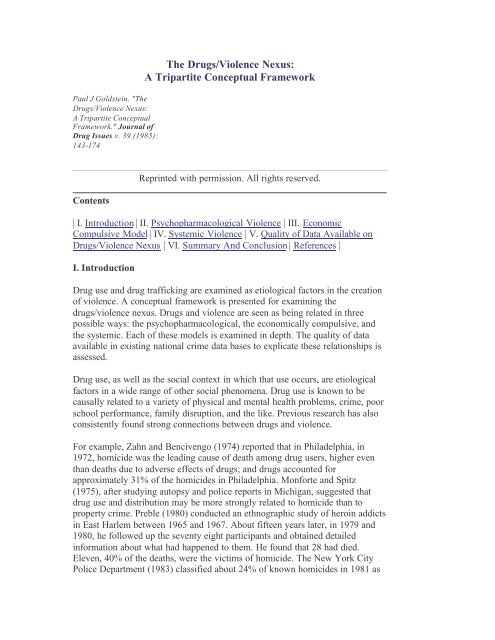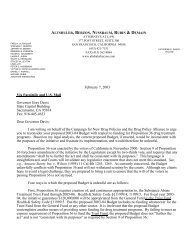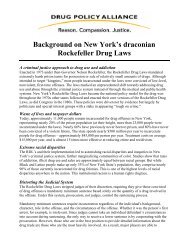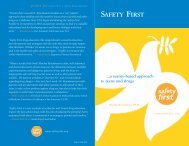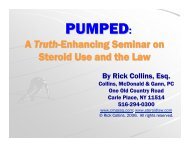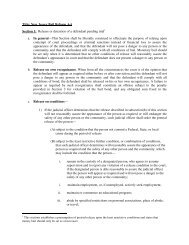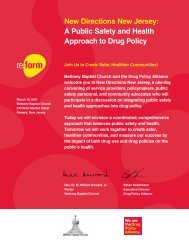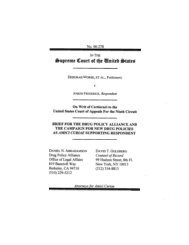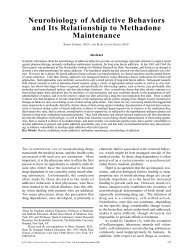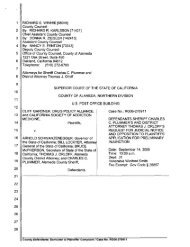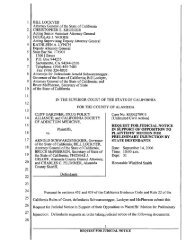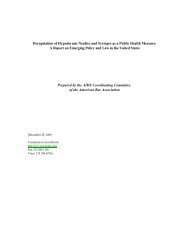The Drugs/Violence Nexus: A Tripartite Conceptual Framework
The Drugs/Violence Nexus: A Tripartite Conceptual Framework
The Drugs/Violence Nexus: A Tripartite Conceptual Framework
Create successful ePaper yourself
Turn your PDF publications into a flip-book with our unique Google optimized e-Paper software.
Paul J Goldstein. "<strong>The</strong><br />
<strong>Drugs</strong>/<strong>Violence</strong> <strong>Nexus</strong>:<br />
A <strong>Tripartite</strong> <strong>Conceptual</strong><br />
<strong>Framework</strong>." Journal of<br />
Drug Issues v. 39 (1985):<br />
143-174<br />
Contents<br />
<strong>The</strong> <strong>Drugs</strong>/<strong>Violence</strong> <strong>Nexus</strong>:<br />
A <strong>Tripartite</strong> <strong>Conceptual</strong> <strong>Framework</strong><br />
Reprinted with permission. All rights reserved.<br />
| I. Introduction | II. Psychopharmacological <strong>Violence</strong> | III. Economic<br />
Compulsive Model | IV. Systemic <strong>Violence</strong> | V. Quality of Data Available on<br />
<strong>Drugs</strong>/<strong>Violence</strong> <strong>Nexus</strong> | VI. Summary And Conclusion | References |<br />
I. Introduction<br />
Drug use and drug trafficking are examined as etiological factors in the creation<br />
of violence. A conceptual framework is presented for examining the<br />
drugs/violence nexus. <strong>Drugs</strong> and violence are seen as being related in three<br />
possible ways: the psychopharmacological, the economically compulsive, and<br />
the systemic. Each of these models is examined in depth. <strong>The</strong> quality of data<br />
available in existing national crime data bases to explicate these relationships is<br />
assessed.<br />
Drug use, as well as the social context in which that use occurs, are etiological<br />
factors in a wide range of other social phenomena. Drug use is known to be<br />
causally related to a variety of physical and mental health problems, crime, poor<br />
school performance, family disruption, and the like. Previous research has also<br />
consistently found strong connections between drugs and violence.<br />
For example, Zahn and Bencivengo (1974) reported that in Philadelphia, in<br />
1972, homicide was the leading cause of death among drug users, higher even<br />
than deaths due to adverse effects of drugs; and drugs accounted for<br />
approximately 31% of the homicides in Philadelphia. Monforte and Spitz<br />
(1975), after studying autopsy and police reports in Michigan, suggested that<br />
drug use and distribution may be more strongly related to homicide than to<br />
property crime. Preble (1980) conducted an ethnographic study of heroin addicts<br />
in East Harlem between 1965 and 1967. About fifteen years later, in 1979 and<br />
1980, he followed up the seventy eight participants and obtained detailed<br />
information about what had happened to them. He found that 28 had died.<br />
Eleven, 40% of the deaths, were the victims of homicide. <strong>The</strong> New York City<br />
Police Department (1983) classified about 24% of known homicides in 1981 as
drug related. <strong>The</strong> drugs/violence nexus also appears consistently in newspaper<br />
headlines. For example, a seventeen year old boy who committed suicide by<br />
hanging himself in his jail cell had earlier confessed to committing a ritual<br />
stabbing and mutilation killing of another youth because he believed the boy had<br />
stolen ten bags of PCP from him (New York Times, July 12,1984). A New York<br />
City Transit policeman was beaten with his own nightstick and his chin was<br />
nearly bitten off by a farebeater who was high on angel dust (New York Post,<br />
September 19, 1984). A thirty-nine year old mother of three was killed by a<br />
stray bullet fired during a fight between drug dealers on the lower east side of<br />
Manhattan (New York Post, October 10, 1984). A front page headline in the<br />
New York Times (October 29,1984) claimed that "Increase in Gang Killings on<br />
Coast is Traced to Narcotics Trafficking." Less than a month later, another New<br />
York Times front page headline announced that "Cocaine Traffickers Kill 17 in<br />
Peru Raid on Antidrug Team" ( November 19, 1984) A Miami police official<br />
was quoted on television as saying that one-third of the homicides in Miami in<br />
1984 were cocaine related.<br />
Even though the relationship between drugs and violence has been consistently<br />
documented in both the popular press and in social scientific research, it is only<br />
recently that attempts have been made to assess this problem on a national level.<br />
One such effort estimated that 10% of the homicides and assaults nationwide are<br />
the result of drug use (Harwood et al., 1984). Another recent report estimated<br />
that in the United States, in 1980, over 2,000 homicides were drug related and.<br />
assuming an average life span of 65 years, resulted in the loss of about 70,000<br />
years of life. This report further estimated that in 1980 over 460,000 assaults<br />
were drug related, and that in about 140,000 of these assaults the victims<br />
sustained physical injury leading to about 50,000 days of hospitalization<br />
(Goldstein and Hunt, 1984). While the association between drugs and violence<br />
appears strong, and drug use and trafficking appear to be important etiological<br />
factors in the incidence of violence, there has been little effort to place this<br />
relationship into a conceptual framework to guide further empirical research.<br />
<strong>The</strong> purpose of this paper is to introduce such a framework.<br />
Information for this report was gathered during the course of three separate<br />
empirical investigations. Sixty women were interviewed in 1976 and 1977 for a<br />
study of the relationship between prostitution and drugs (Goldstein, 1979).<br />
Between 1978 and 1982, an ethnographic study was undertaken of the economic<br />
behavior of 201 street opiate users in Harlem. (This research was supported by<br />
the New York State Division of Substance Abuse Services; by a Public Health<br />
Service Award from the National Institute on Drug Abuse (RO1-DA 01926);<br />
and by an interagency agreement between NIDA (RO1-DA 02355) and the Law<br />
Enforcement Assistance Administration (LEAA-J-IAA-005-8).) Finally, in<br />
1984, I began a study of the relationship between drugs and violence on the<br />
lower east side of Manhattan. (This research is being supported by the New<br />
York State Division of Substance Abuse Services and by a Public Health<br />
Service Award from the National Institute on Drug Abuse (RO1-DA 03182).)
That study is guided by the conceptual framework presented below.<br />
<strong>Drugs</strong> and violence are seen as being related in three possible ways: the<br />
psychopharmacological, the economically compulsive, and the systemic. Each<br />
of these models must be viewed, in a theoretical sense, as "ideal types," i.e., as<br />
hypothetically concrete ". . . devices intended to institute comparisons as precise<br />
as the stage of one's theory and the precision of one's instruments allow."<br />
(Martindale, 1959:58- 59). In fact, it will be shown below that there can be<br />
overlap between the three models. However, this overlap does not detract from<br />
the heuristic value of the tripartite conceptual framework.<br />
II. Psychopharmacological <strong>Violence</strong><br />
<strong>The</strong> psychopharmacological model suggests that some individuals, as a result of<br />
short or long term ingestion of specific substances, may become excitable,<br />
irrational, and may exhibit violent behavior. <strong>The</strong> most relevant substances in this<br />
regard are probably alcohol, stimulants, barbiturates and PCP. A lengthy<br />
literature exists examining the relationship between these substances and<br />
violence (Tinklenberg, 1973; Virkunnen, 1974; Glaser, 1974; Gerson et al.,<br />
1979; Ellinswood, 1971; Smith, 1972; Asnis and Smith, 1978; d'Orban, 1976;<br />
Feldman et al., 1979).<br />
Early reports which sought to employ a psychopharmacological model to<br />
attribute violent behavior to the use of opiates and marijuana have now been<br />
largely discredited (Finestone, 1967; Inciardi and Chambers, 1972; Kozel et al.,<br />
1972; Greenberg and Adler, 1974; Schatzman, 1975; Kramer, 1976). In a classic<br />
statement of this point, Kolb argued the following.<br />
<strong>The</strong>re is probably no more absurd fallacy prevalent, than the notion that murders<br />
are committed and daylight robberies and holdups are carried out by men<br />
stimulated by large doses of cocaine or heroin which have temporarily distorted<br />
them into self-imagined heroes incapable of fear ... violent crime would be much<br />
less prevalent if all habitual criminals were addicts who could obtain sufficient<br />
morphine or heroin to keep themselves fully charged with one of these drugs at<br />
all times (Kolb,1925:78).<br />
Kolb's point must be modified in one very important way. He is correct in<br />
claiming that ingestion of opiates is unlikely to lead to violence. However, the<br />
irritability associated with the withdrawal syndrome from opiates may indeed<br />
lead to violence. For example, in previous research on the relationship between<br />
drugs and prostitution I found that heroin using prostitutes often linked robbing<br />
and/or assaulting clients with the withdrawal experience (Goldstein,1979).<br />
<strong>The</strong>se women reported that they preferred to talk a "trick" out of his money, but<br />
if they were feeling "sick," i.e., experiencing withdrawal symptoms, that they<br />
would be too irritable to engage in gentle conning. In such cases they might<br />
attack the client, take his money, purchase sufficient heroin to "get straight," and
then go back on the street. In a more relaxed physical and mental state, these<br />
women claimed that they could then behave like prostitutes rather than robbers.<br />
Drug use may also have a reverse psychopharmacological effect and ameliorate<br />
violent tendencies. In such cases, persons who are prone to acting violently may<br />
engage in self- medication in order to control their violent impulses. Several<br />
subjects have reported doing this. <strong>The</strong> drugs chosen for this function are<br />
typically heroin or tranquilizers.<br />
Psychopharmacological violence may involve drug use by either offender or<br />
victim. In other words, drug use may contribute to a person behaving violently,<br />
or it may alter a person's behavior in such a manner as to bring about that<br />
person's violent victimization. Previous research indicates relatively high<br />
frequencies of alcohol consumption in rape (Amir, 1971; Rada, 1975) and<br />
homicide victims (Shupe, 1954; Wolfgang, 1958). Public intoxication may<br />
invite a robbery or mugging. One study found that in rapes where only the<br />
victim was intoxicated, she was significantly more likely to be physically<br />
injured (Johnson et al.,1973).<br />
It is difficult to estimate the true rate of victim precipitated<br />
psychopharmacological violence because many such instances go unreported<br />
and, hence, unrecorded in official records. My own research in New York over<br />
the last decade indicated that many intoxicated victims do not report their<br />
victimization. Such victims say that they do not wish to talk to the police while<br />
drunk or "stoned." Further, since they are frequently confused about details of<br />
the event and, perhaps, unable to remember what their assailant looked like, they<br />
argue that reporting the event would be futile.<br />
Assuming that the psychopharmacological violence is not precipitated by the<br />
victim, the victim can then be just about anybody. Psychopharmacological<br />
violence can erupt in the home and lead to spouse or child abuse.<br />
Psychopharmacological violence can occur in the workplace, on the streets, in<br />
bars, and so on. <strong>The</strong> incidence of psychopharmacological violence is impossible<br />
to assess at the present time, both because many instances go unreported and<br />
because when cases are reported the psychopharmacological state of the<br />
offender is seldom recorded in official records.<br />
(Top)<br />
III. Economic Compulsive Model<br />
<strong>The</strong> economically compulsive model suggests that some drug users engage in<br />
economically oriented violent crime, e.g., robbery, in order to support costly<br />
drug use. Heroin and cocaine, because they are expensive drugs typified by<br />
compulsive patterns of use, are the most relevant substances in this category.<br />
Economically compulsive actors are not primarily motivated by impulses to act
out violently. Rather, their primary motivation is to obtain money to purchase<br />
drugs. <strong>Violence</strong> generally results from some factor in the social context in which<br />
the economic crime is perpetrated. Such factors include the perpetrator's own<br />
nervousness, the victim's reaction, weaponry (or the lack of it) carried by either<br />
offender or victim the intercession of bystanders, and so on.<br />
Research indicates that most heroin users avoid violent acquisitive crime if<br />
viable non-violent alternatives exist (Preble and Casey, 1969; Swezey, 1973;<br />
Cushman, 1974; Gould, 1974; Goldstein and Duchaine, 1980; Goldstein, 1981:<br />
Johnson et al., 1985). This is because violent crime is more dangerous, embodies<br />
a greater threat of prison if one is apprehended, and because perpetrators may<br />
lack a basic orientation toward violent behavior. Bingham Dai reported similar<br />
findings nearly fifty years ago. His study of the criminal records of over one<br />
thousand opiate addicts in Chicago revealed that the most common offenses for<br />
which they were arrested were violations of the narcotics laws, followed by<br />
offenses against property.<br />
. . . it is interesting to note that comparatively few of them resorted to violence<br />
in their criminal activities. <strong>The</strong> small percentage of addicts committing such<br />
crimes as robbery, assault and battery, homicide and others that involve the use<br />
of force seems to discredit the view shared by many that the use of drugs has the<br />
effect of causing an individual to be a heartless criminal. On the contrary, our<br />
figures suggest that most of the crimes committed by addicts were of a peaceful<br />
nature that involve more the use of wit than that of force (Dai, 1937:69).<br />
Victims of economic compulsive violence, like those of psychopharmacological<br />
violence, can be anybody. Previous research (Goldstein and Johnson, 1983;<br />
Johnson et al., 1985) indicates that the most common victims of this form of<br />
drug related violence are people residing in the same neighborhoods as the<br />
offender. Frequently the victims are engaged in illicit activities themselves.<br />
Other drug users, strangers coming into the neighborhood to buy drugs, numbers<br />
runners, and prostitutes are all common targets of economic compulsive<br />
violence.<br />
While research does indicate that most of the crimes committed by most of the<br />
drug users are of the nonviolent variety, e.g., shoplifting, prostitution, drug<br />
selling, there are little data that indicate what proportion of violent economic<br />
crimes are committed for drug related reasons. No national criminal justice<br />
databases contain information on the motivations or drug use pattern of<br />
offenders as they relate to specific crimes.<br />
(Top)<br />
IV. Systemic <strong>Violence</strong><br />
In the systemic model, violence is intrinsic to involvement with any illicit
substance. Systemic violence refers to the traditionally aggressive patterns of<br />
interaction within the system of drug distribution and use. Some examples of<br />
systemic violence follow below. 1. disputes over territory between rival drug<br />
dealers. 2. assaults and homicides committed within dealing hierarchies as a<br />
means of enforcing normative codes. 3. robberies of drug dealers and the usually<br />
violent retaliation by the dealer or his/her bosses. 4. elimination of informers. 5.<br />
punishment for selling adulterated or phony drugs. 6. punishment for failing to<br />
pay one's debts. 7. disputes over drugs or drug paraphernalia 8. robbery violence<br />
related to the social ecology of copping areas. Substantial numbers of users of<br />
any drug become involved in drug distribution as their drug-using careers<br />
progress and, hence, increase their risk of becoming a victim or perpetrator of<br />
systemic violence. Examples of each type of systemic violence mentioned above<br />
are readily available.<br />
We recently reported that much of the heroin in New York City is being<br />
distinctively packaged and sold under "brand names" (Goldstein et al., 1984).<br />
<strong>The</strong>se labeling practices are frequently abused and this abuse has led to<br />
violence. Among the more common abuses are the following: Dealers mark an<br />
inferior quality heroin with a currently popular brand name. Users purchase the<br />
good heroin, use it, then repackage the bag with milk sugar for resale. <strong>The</strong><br />
popular brand is purchased, the bag is "tapped," and further diluted for resale.<br />
<strong>The</strong>se practices get the real dealers of the popular brand very upset. <strong>The</strong>ir heroin<br />
starts to get a bad reputation on the streets and they lose sales. Purchasers of the<br />
phony bags may accost the real dealers, complaining about the poor quality and<br />
demanding their money back. <strong>The</strong> real dealers then seek out the purveyors of the<br />
phony bags. Threats, assaults, and/or homicides may ensue.<br />
A common form of norm violation in the drug trade is known as "messing up the<br />
money." Basically, this involves a subordinate returning less money to his<br />
superior than is expected. For example, a street dealer is given a consignment of<br />
drugs to sell and is expected to return to his supplier or lieutenant with a specific<br />
amount of money. However, for any of a variety of reasons, he returns with too<br />
little money or fails to return at all. Some of the reasons why he might be short<br />
on his money are that he used some or all of the drugs himself; he sold all of the<br />
drugs, but then spent some or all of the money; he gave out too many "shorts,"<br />
i.e., he sold the drugs for less than he should have; he was robbed, either of his<br />
drugs or of the money that he obtained from selling them.<br />
When a street dealer fails to return sufficient money, his superior has several<br />
options. If only a small amount of money is involved, and the street dealer has<br />
few prior transgressions and a convincing justification for the current shortage,<br />
his superior is likely to give him another consignment and allow him to make up<br />
the shortage from his share of the new consignment. Other options include firing<br />
the street dealer, having him beaten up, or having him killed. In a recent study, a<br />
lieutenant in a heroin dealing operation had been rather lax in supervising the six
street dealers working under him. Just about everybody was messing up the<br />
money, including himself. One day the supplier and two soldiers' picked up the<br />
lieutenant and took him for a ride in their car. <strong>The</strong> lieutenant was afraid that he<br />
was going to be killed. However, after cruising for a while, they spotted one of<br />
the street dealers who had been "messing up the money." <strong>The</strong> two soldiers<br />
jumped from the car and beat him with iron pipes. <strong>The</strong>y positioned him in the<br />
street and drove the car over his legs, crippling him for life. <strong>The</strong> supplier then<br />
suggested to the lieutenant that he would be well advised to run the operation<br />
more tightly in the future.<br />
An interesting addendum to this discussion is that the "code of the streets<br />
dictates that blood cancels all debts." In other words, if a street dealer has<br />
"messed up the money" and is subsequently beaten up or wounded, then he no<br />
longer owes the money <strong>The</strong> shedding of blood has canceled the debt. <strong>The</strong> above<br />
account illustrates a direct punishment for a norm violation. <strong>Violence</strong> may also<br />
arise in the course of a dispute that stems from a norm violation. I was recently<br />
told of such an incident. A drug dealer operated out of an apartment in New<br />
York City. Prospective purchasers would line up in the hallway of the apartment<br />
house and give their money to a young Hispanic woman who worked for the<br />
dealer. <strong>The</strong> woman would then get the drugs from the dealer and give them to<br />
the buyers. Dealers seldom allow customers into the space where the drugs are<br />
actually kept. One day the line was long and three Black men waited patiently to<br />
make their purchase. Finally it was their turn. However, the woman bypassed<br />
them in favor of two Hispanic men who were at the back of the line. <strong>The</strong><br />
Hispanic men made a large purchase and the woman announced that the dealer<br />
had sold out for the day. <strong>The</strong> Blacks were furious. An argument ensued, shots<br />
were fired, and one of the Hispanic men was killed. <strong>The</strong> norm violator in this<br />
case, the woman, was fired by the dealer.<br />
A common precipitator of violence in the drug scene is the robbery of a dealer.<br />
No dealer who wishes to stay in business can allow himself or his associates to<br />
be robbed. Most dealers maintain an arsenal of weapons and a staff that knows<br />
how to use them. A subject in a recent study reported going with two friends to<br />
"take off" a neighborhood social club that was a narcotics distribution center. In<br />
the course of the hold-up they shot one of the employees and beat up several<br />
other men and women. In retrospect, the subject admitted that they had probably<br />
used excessive force, but that at the time it had seemed justified because they<br />
were outnumbered about fifteen to three. One of the victims recognized one of<br />
the robbers. This robber was later shot to death in the street.<br />
<strong>The</strong> Pulitzer Prize winning study of narcotics trafficking, <strong>The</strong> Heroin Trail,<br />
documents many instances of systemic violence. One concerns Joseph Fucillo, a<br />
Brooklyn drug dealer who became a police informant in 1972.<br />
One day, as his wife watched from the window of their home in the Bensonhurst<br />
section of Brooklyn, Fucillo backed his car out of the driveway, and two men in
ski masks walked up to it. Two guns fired rapidly and seven bullets went into<br />
Fucillo's head. He died. (Newsday Staff and Editors, 1974:226)<br />
A pimp stated that he would never allow a "junkie broad" to work for him. One<br />
of his reasons was that an addicted woman might be easily turned into an<br />
informant by the police. When asked what he would do if one of his women did<br />
start to use narcotics, he replied that if she didn't know too much about his<br />
activities he would just fire her. However, if she did know too much, he would<br />
kill her. (Goldstein, 1979:107)<br />
New York Magazine reported an event that was tragic both in its consequences<br />
and in the fact that it is so typical of the current drug scene.<br />
Sylvester, a 16 year old boy is stabbed in the chest . . . in the Crown Heights<br />
section of Brooklyn. He is taken to St. Mary's Hospital and dies a short time<br />
later. According to a witness, Sylvester sold marijuana to a group of adolescents<br />
a few days before the incident. His customers were apparently dissatisfied with<br />
its quality. Tonight the teenagers, a group of about eight or ten, find Sylvester on<br />
the street and complain about the bad grass. <strong>The</strong> leader of the group, John<br />
Green, demands their money back. Sylvester then picks up a couple of bottles<br />
and throws them at the group, running away down the block. <strong>The</strong> teenagers<br />
chase Sylvester down Lincoln Place where he picks up a stick and starts<br />
swinging. Knocking the stick out of his hand, John Green plunges a four inch<br />
knife into Sylvester's chest. Green and the others escape from the scene. At one<br />
P.M. Sunday afternoon, in apparent retaliation for the Sylvester murder, John<br />
Green is shot once in the left rear side of the body. He too is taken to St. Mary's,<br />
where he too dies (Goro, 1977:31).<br />
<strong>Violence</strong> associated with disputes over drugs have long been endemic in the<br />
drug world. Friends come to blows because one refuses to give the other a<br />
"taste." A husband beats his wife because she raided his "stash."<br />
<strong>The</strong> current AIDS scare has led to an increasing amount of violence because of<br />
intravenous drug users' fear of contracting this fatal disease from contaminated<br />
"works." Some sellers of needles and syringes claim that the used works that<br />
they are trying to sell are actually new and unused. If discovered by would-be<br />
purchasers, violence may ensue. I was recently told of one incident that<br />
allegedly led to the death of two men. A heroin user kept a set of works in a<br />
"shooting gallery" that were for his exclusive use. One day another man used<br />
these works <strong>The</strong> owner of the works discovered what had happened and stabbed<br />
this man to death. He later stabbed a friend to death who was present when the<br />
stranger had used the works, had done nothing to stop him, and had failed to<br />
inform the owner of what had happened.<br />
<strong>The</strong> social ecology of copping areas is generally well suited for the perpetration<br />
of robbery violence. Most major copping areas in New York City are located in
poor ghetto neighborhoods, such as Harlem. In these neighborhoods, drug users<br />
and dealers are frequent targets for robberies because they are known to be<br />
carrying something of value and because they are unlikely to report their<br />
victimization. Dealers are sometimes forced to police their own blocks so that<br />
customers may come and go in safety.<br />
A subject in a current study earns money by copping drugs for other people. He<br />
stated that he was recently forced to protect one of his clients by fighting off two<br />
would-be robbers with a garbage can lid. Interestingly, he knew the two<br />
attackers from the street, but he claimed to harbor no ill will towards them. He<br />
stated that they did what they had to do and he did what he had to do.<br />
Victims of systemic violence are usually those involved in drug use or<br />
trafficking. Occasionally, noninvolved individuals become innocent victims.<br />
<strong>The</strong> case of a woman being killed by a stray bullet fired in a dispute between<br />
rival drug dealers was cited earlier. Several cases have been reported where<br />
whole families of drug dealers, including wives and young children, have<br />
perished in narcotics gang wars. However, the vast majority of victims of<br />
systemic violence are those who use drugs, who sell drugs, or are otherwise<br />
engaged in some aspect of the drug business.<br />
Various sources have stressed the importance of what I have termed the<br />
systemic model in explaining drugs/violence relationships. Blum (1969) points<br />
out that, with the exception of alcohol, most drug users are not violent but that<br />
this point does not apply to the typical dealer for whom there is strong evidence<br />
linking drugs and violence. Smith (1972) in his discussion of amphetamines and<br />
violence in San Francisco's Haight-Ashbury district, stated that the primary<br />
cause of violence on the streets was "burning," i.e., selling phony or adulterated<br />
drugs. Several sources suggest that studying the area of systemic violence may<br />
be more important than the study of the relationship of drug use to crime on the<br />
level of the individual user.<br />
Racket associated violence, a result of the intense competition for enormous<br />
profits involved in drugs, is flourishing. This is not the crime in the streets which<br />
is often associated with drugs, but an underworld in which ordinarily those<br />
people suffer from violence who in one way or another have become related to<br />
the traffic (Fitzpatrick, 1974:360).<br />
Because these criminal entrepreneurs operate outside the law in their drug<br />
transactions, they are not bound by business etiquette in their competition with<br />
each other, in their collection of debts, or in their nondrug investments. Terror,<br />
violence, extortion, bribery, or any other expedient strategy is relied upon by<br />
these criminals . . . (Glaser, 1974:53).<br />
Where a commodity is scarce and highly in demand (as may be the case with<br />
drugs), extreme measures of control, i.e., homicide, may be involved. Further, in
areas of high scarcity and inelastic demand, bitter arguments centering on the<br />
commodity are likely to ensue. When such arguments take place in a subculture<br />
where violence is the modus operandi, and where implements of violence, e.g.,<br />
guns, are readily available, homicide is likely to be the result (Zahn, 1975:409).<br />
Zahn pointed out the importance of systemic violence in her recent study of<br />
homicide in twentieth century United States. She showed that homicide rates<br />
peaked in the 1920s and early 1930s, declined and leveled off thereafter, began<br />
to rise in 1965, and peaked again in 1974. This analysis led to the following<br />
conclusion.<br />
In terms of research directions this historical review would suggest that closer<br />
attention be paid to the connection between markets for illegal goods and the<br />
overall rate of homicide violence. It seems possible, if not likely, that<br />
establishing and maintaining a market for illegal goods (booze in the 1920s and<br />
early 1930s; heroin and cocaine in the late 1960s and early 1970s) may involve<br />
controlling and/or reducing the competition, solving disputes between alternate<br />
suppliers or eliminating dissatisfied customers .... <strong>The</strong> use of guns in illegal<br />
markets may also be triggered by the constant fear of being caught either by a<br />
rival or by the police. Such fear may increase the perceived need for protection,<br />
i.e., a gun, thus may increase the arming of these populations and a resulting<br />
increased likelihood of use. For the overall society this may mean a higher<br />
homicide rate (Zahn, 1980:128).<br />
It was stated above that the three models of the drugs/violence nexus contained<br />
in the tripartite conceptual framework should be viewed as ideal types, and that<br />
overlap could occur between them. For example, a heroin user preparing to<br />
commit an act of economic compulsive violence, e.g., a robbery, might ingest<br />
some alcohol or stimulants to give himself the courage to do the crime. This<br />
event now contains elements of both economic compulsive and<br />
psychopharmacological violence. If the target of his robbery attempt was a drug<br />
dealer, the event would contain elements of all three types of drug related<br />
violence.<br />
<strong>The</strong> conceptual framework allows the event to be effectively analyzed and<br />
broken down into constituent parts and processes. <strong>The</strong> roles played in the event<br />
by different sorts of drugs can be explicated. In the above example, the need for<br />
money to purchase heroin was the primary motivation for the act. Alcohol and<br />
stimulants were ingested after the act was decided upon because of the robber's<br />
need for courage and, presumably, because prior experience with these<br />
substances led the perpetrator to believe that they would serve that<br />
psychopharmacological function.<br />
<strong>The</strong> choice of target, a drug dealer, is open for empirical investigation. It may<br />
turn out that the reason the heroin user needed to commit the robbery was<br />
because that dealer had cheated him earlier in the day on a drug purchase,
perhaps selling him "dummy" bags. Our robber, needing to "get straight" and<br />
not having any more money, decides that robbing this unscrupulous dealer<br />
would be an appropriate revenge. Several subjects in our studies reported<br />
committing economic compulsive acts out of fear of becoming a victim of<br />
systemic violence. <strong>The</strong>se were street dealers who had "messed up the money"<br />
and who were terrified of what their superiors might do to them. Some had<br />
already been threatened. This motivated them to do robberies as a quick way to<br />
obtain the money that they owed.<br />
Thus, as the concepts are employed, a fuller understanding of the event emerges.<br />
<strong>The</strong> roles played by specific drugs become clearer. <strong>The</strong> actor's motivations and<br />
the process by which he undertakes to commit a robbery are elaborated upon.<br />
If the above events were to be examined in official crime records, assuming they<br />
were reported, they would be listed as robberies. Victim-perpetrator<br />
relationships would probably be unknown, though they might be listed as<br />
"acquaintance" or "stranger." No mention of drugs would be made. Victims of<br />
systemic violence frequently lie to the police about the circumstances of their<br />
victimization. Not a single research subject whom I have interviewed who was<br />
the victim of systemic violence, and who was forced to give an account of his or<br />
her victimization to the police, admitted that he or she had been assaulted<br />
because of owing a drug supplier money or selling somebody phony or<br />
adulterated drugs. All such victims simply claimed to have been robbed.<br />
It would make little difference if the robbery were to develop into a homicide.<br />
<strong>The</strong> classification of the event would change from robbery to homicide, but<br />
victim-perpetrator relationship and nature of the homicide would remain<br />
unknown or be coded in such a broad fashion that the information would not be<br />
very useful. No mention of drugs would be made. Attention will now be focused<br />
on the quality of data available on the national level to elaborate on the<br />
drugs/violence nexus.<br />
(Top)<br />
V. Quality of Data Available on <strong>Drugs</strong>/<strong>Violence</strong> <strong>Nexus</strong><br />
<strong>The</strong> drugs/violence nexus is one of the most important criminological and health<br />
issues for which rigorously collected data is currently unavailable. While a<br />
variety of ethnographic studies focus on violent behavior of drug users, most of<br />
this material is not quantitative and does not allow national projections to be<br />
made. Official statistics collected in the criminal justice and health care systems<br />
do not link acts of criminal violence and resultant injuries or death to antecedent<br />
drug activity of victims or perpetrators. Broad recording categories make it<br />
virtually impossible to determine whether the offender or victim was a drug user<br />
or distributor, or whether the pharmacological status of either victim or offender
was related to the specific event.<br />
Uniform Crime Reports (UCR), collected by the Federal Bureau of<br />
Investigation, is the most visible source of crime data in the country. However, it<br />
is not very useful for an elaboration of the relationship between drugs and<br />
violence. UCR is a measure of crimes known to the police. Many crimes are not<br />
reported. <strong>The</strong> 1980 National Crime Survey found that the following proportions<br />
of violent victimizations were not reported to the police: 57% of the rapes; 41%<br />
of the robberies; 52% of the assaults (BJS, 1982:71). UCR data on homicide,<br />
due to the presence of a body, is the most reliable crime incidence category.<br />
Reporting schedules to which local law enforcement agencies must adhere<br />
frequently result in data being submitted to UCR before investigative work has<br />
been completed and, hence, large numbers of unknowns usually appear in<br />
relevant categories. <strong>The</strong> New York City Police Department has addressed this<br />
issue by holding an annual debriefing of detective squad commanders about all<br />
homicides that occurred in their precincts during the preceding year. It was in<br />
the context of these debriefings that the significance of drug related homicides<br />
first emerged and became an important analytic category for the NYPD Crime<br />
Analysis Unit. <strong>The</strong> new data gathered during these debriefings have never been<br />
included in UCR because no structure exists for their transmission. This has led<br />
to such curious statistical phenomena as New York City reporting more drug<br />
related homicides for a given year than UCR reports for the nation as a whole,<br />
including New York City.<br />
<strong>The</strong> major difficulty in using UCR to estimate drug related violent crime is the<br />
lack of a descriptive component to supplement the quantitative presentation. <strong>The</strong><br />
drug relatedness of violent events is simply not coded. <strong>The</strong>refore, it is not<br />
possible to link specific violent acts to antecedent drug activities of either victim<br />
or perpetrator.<br />
An alternative data source is the National Crime Survey (NCS). This annual<br />
report issued by the Bureau of Justice Statistics (BJS) is based on data obtained<br />
from a stratified, multistage cluster sample. <strong>The</strong> basic sampling unit is the<br />
household. Respondents within households are asked for all instances of<br />
victimization in the past year. Projections are then made to the nation as a<br />
whole.<br />
As was the case with UCR, the NCS is not very useful for elaborating on the<br />
drugs/violence nexus. Street drug users frequently are not part of a household,<br />
i.e., they may sleep in abandoned buildings, in subways, on park benches. Thus,<br />
a population that is posited to be at especially high risk for drug related violence<br />
is likely to be underrepresented in this data. Also, victims may have difficulty<br />
recalling specific events or be reluctant to describe them to an interviewer.<br />
Research on the capacity of victims to recall specific kinds of crime . . .
indicates that assault is the least well recalled of the crimes measured by the<br />
NCS. This may stem in part from the observed tendency of victims not to report<br />
crimes committed by offenders known to them, especially if they are relatives.<br />
In addition, it is suspected that, among certain groups, crimes that contain the<br />
elements of assault are a part of everyday life and, thus, are simply forgotten or<br />
are not considered worth mentioning to a survey interviewer. Taken together,<br />
these recall problems may result in a substantial understatement of the "true"<br />
rate of victimization from assault (BJS, 1982:94).<br />
A major problem with the NCS is that victims seldom know the motivation of<br />
offenders for committing acts of violence. Of course, this is less the case with<br />
systemic violence than it is with either psychopharmacological or economic<br />
compulsive violence. With regard to psychopharmacological violences victims<br />
may not be able to discern that assailants are "high" and, even if they could, it<br />
would be difficult to ascertain what substances are involved. Similarly, victims<br />
of economic compulsive violence may not know that they are being robbed in<br />
order to finance a drug habit.<br />
(Top)<br />
VI. Summary And Conclusion<br />
<strong>Drugs</strong> and violence were shown to be related in three possible ways:<br />
psychopharmacologically, economic compulsively, and systemically. <strong>The</strong>se<br />
different forms of drug related violence were shown to be related to different<br />
types of substance use, different motivations of violent perpetrators, different<br />
types of victims, and differential influence by social context. Current methods of<br />
collecting national crime data were shown to be insensitive to the etiological<br />
role played by drug use and trafficking in creating violent crime.<br />
No evidence currently exists as to the proportions of violence engaged in by<br />
drug users and traffickers that may be attributed to each of the three posited<br />
models. We need such data. My own impression, arising from research in New<br />
York, is that the area of systemic violence accounts for most of the violence<br />
perpetrated by, and directed at, drug users. Systemic violence is normatively<br />
embedded in the social and economic networks of drug users and sellers. Drug<br />
use, the drug business, and the violence connected to both of these phenomena,<br />
are all aspects of the same general life style. Individuals caught in this lifestyle<br />
value the experience of substance use, recognize the risks involved, and struggle<br />
for survival on a daily basis. That struggle is clearly a major contributor to the<br />
total volume of crime and violence in American society.<br />
References<br />
Amir, M. 1971 Patterns in Forcible Rape. Chicago: University of Chicago Press.
Asnis, S. and R. Smith 1978 Amphetamine Abuse and <strong>Violence</strong>, Journal of<br />
Psychedelic <strong>Drugs</strong>, 10:317-377.<br />
Biernacki, P. 1979 Junkie Work, Hustles and Social Status among Heroin<br />
Addicts, Journal of Drug Issues, 9:535-550.<br />
Bureau of Justice Statistics 1982 Criminal Victimization in the United States,<br />
1980. Washington, DC: United States Department of Justice.<br />
Cushman, P. 1974 Relationship between Narcotic Addiction and Crime, Federal<br />
Probation, 38:38-43.<br />
Dai, B. 1937 Opium Addiction in Chicago. Montclair: Patterson Smith.<br />
d'Orban, P. T 1976 Barbiturate Abuse, Journal of Medical Ethics, 2:63- 67.<br />
Eckerman, W., J. Bates, J. Rachall and W. Poole 1971 Drug Usage and Arrest<br />
Charges: A Study of Drug Usage and Arrest Charges among Arrestees in Six<br />
Metropolitan Areas of the United States. Washington, DC: United States<br />
Department of Justice.<br />
Ellinswood, E. 1971 Assault and Homicide Associated with Amphetamine<br />
Abuse, American Journal of Psychiatry, 127:1170- 1175.<br />
Feldman, H., M. H. Agar and G. M. Beschner (eds.) 1979 Angel Dust: An<br />
Ethnographic Study of PCP Users. Lexington: Lexington Books.<br />
Finestone, H. 1967 Narcotics and Criminality, Law and Contemporary<br />
Problems, 22:60-85.<br />
Fink, L. and M. Hyatt 1978 Drug Use and Violent Behavior, Journal of Drug<br />
Education, 8:139- 149.<br />
Fitzpatrick, J. P. 1974 <strong>Drugs</strong>, Alcohol and Violent Crime, Addictive Diseases,<br />
1:353- 367.<br />
Gerson, L. W. and D. A. Preston 1979 Alcohol Consumption and the Incidence<br />
of Violent Crime, Journal of Studies on Alcohol, 40:307-312.<br />
Glaser, D. 1974 Interlocking Dualities in Drug Use, Drug Control and Crime, in<br />
Inciardi, J. A and C. Chambers (eds.), <strong>Drugs</strong> and the Criminal Justice System.<br />
Beverly Hills: Sage Publications.<br />
Goldstein, P. J. 1979 Prostitution and <strong>Drugs</strong>. Lexington: Lexington Books.<br />
Getting 1981 Over: Economic Alternatives to Predatory Crime among Street
Drug Users, in Inciardi, J. A. (ed.), <strong>The</strong> <strong>Drugs</strong>/Crime Connection. Beverly Hills:<br />
Sage Publications.<br />
Goldstein, P. J. and N. Duchaine 1980 Daily Criminal Activities of Street Drug<br />
Users, paper presented at annual meetings of the American Society of<br />
Criminology.<br />
Goldstein, P. J. and B. D. Johnson 1983 Robbery among Heroin Users,<br />
presented at annual meetings of the Society for the Study of Social Problems.<br />
Goldstein, P. J. and D. Hunt 1984 Health Consequences of Drug Use, report to<br />
the Carter Center of Emory University and <strong>The</strong> Centers for Disease Control.<br />
Goldstein, P. J., D. S. Lipton, E. Preble, I. Sobel, T. Miller, W. Abbott, W.<br />
Paige, and F. Soto 1984 <strong>The</strong> Marketing of Street Heroin in New York City,<br />
Journal of Drug Issues, 14:553- 566.<br />
Goro, H. 1977 Saturday Night Dead, New York Magazine, 10:31.<br />
Gould, L. 1974 Crime and the Addict: Beyond Common Sense, in Inciardi, J.<br />
A. and C. Chambers (eds.), <strong>Drugs</strong> and the Criminal Justice System. Beverly<br />
Hills: Sage Publications.<br />
Greenberg, S. and F. Adler 1974 Crime and Addiction: An Empirical Analysis<br />
of the Literature, 1920-1973, Contemporary Drug Problems, 3:221- 270.<br />
Harwood, H., D. Napolitano, P. Kristiansen, and J. Collins 1984 Economic<br />
Costs to Society of Alcohol and Drug Abuse and<br />
Mental Illness. Final report to the Alcohol, Drug Abuse and Mental Health<br />
Administration.<br />
Inciardi, J. A. and C. Chambers 1972 Unreported Criminal Involvement of<br />
Narcotic Addicts, Journal of Drug Issues, 2:57- 64.<br />
Johnson, B. D., P. J. Goldstein, E. Preble, J. Schmeidler, D. S. Lipton, B. Spunt,<br />
and T. Miller 1985 Taking Care of Business: <strong>The</strong> Economics of Crime by<br />
Heroin Abusers. Lexington: Lexington Books.<br />
Johnson, S., L. Gibson and R. Linden 1976 Alcohol and Rape in Winnepeg:<br />
1966-1975, Journal of Studies on Alcohol, 39:1887-1894.<br />
Klepfisz, A. and J. Racy 1973 Homicide and LSD, JAMA 223:429-430.<br />
Kolb, L. 1925 Drug Addiction and its Relation to Crime, Mental Hygiene, 9:74-
89.<br />
Kozel, N., R. Dupont and B. Brown 1972 A Study of Narcotic Involvement in<br />
an Offender Population, International Journal of the Addictions, 7:443-450.<br />
Kramer, J. C. 1976 From Demon to Ally--How Mythology has and may yet alter<br />
National Drug Policy, Journal of Drug Issues, 6:390- 406.<br />
McBride, D. 1981 <strong>Drugs</strong> and <strong>Violence</strong>, in Inciardi, J.A. (ed.), <strong>The</strong> <strong>Drugs</strong>/Crime<br />
Connection. Beverly Hills: Sage Publication.<br />
Martindale, D. 1959 Sociological <strong>The</strong>ory and the Ideal Type, in Gross, L. (ed.),<br />
Symposium on Sociological <strong>The</strong>ory. New York: Harper and Row.<br />
Monforte, J.R. and W.U. Spitz Narcotic Abuse among Homicides in Detroit,<br />
Journal of Forensic Sciences, 20:186- 190.<br />
Newsday Staff and Editors 1974 <strong>The</strong> Heroin Trail. New York: Holt, Rinehart<br />
and Winston.<br />
New York City Police Department 1983 Homicide Analysis: 1981.<br />
Peterson, R. and R. Stillman (eds.) 1978 Phencyclidine Abuse: An Appraisal.<br />
Rockville: National Institute on Drug Abuse.<br />
Preble, E. 1980 El Barrio Revisited, paper presented at annual meetings of the<br />
Society for Applied Anthropology.<br />
Preble, E. and J. Casey 1969 Taking Care of Business: <strong>The</strong> Heroin Users Life on<br />
the Street, International Journal of the Addictions, 4:1-24.<br />
Rada, R. 1975 Alcoholism and Forcible Rape, American Journal of Psychiatry,<br />
132:444-446.<br />
Schatzman, M. 1975 Cocaine and the Drug Problem, Journal of Psychedelic<br />
<strong>Drugs</strong>, 77-18.<br />
Shupe, L.M. 1954 Alcohol and Crime: A Study of the Urine Alcohol<br />
Concentration Found in 882 Persons Arrested During or Immediately After the<br />
Commission of a Felony, Journal of Criminal Law, Criminology and Police<br />
Science, 44:661-664.<br />
Smith, R. 1972 Speed and <strong>Violence</strong>: Compulsive Methamphetamine Abuse and<br />
Criminality in the Haight-Ashbury District, in C. Zarsfonetis (ed.), Drug Abuse:<br />
Proceedings of the International Conference. Philadelphia: Lea and Febiger.
Swezey, R. 1973 Estimating Drug-Crime Relationships, International Journal of<br />
the Addictions. 8:701- 721.<br />
Tinklenberg, J. 1973 <strong>Drugs</strong> and Crime, in National Commission on Marijuana<br />
and Drug Abuse, Drug Use in America: Problems In Perspective. Appendix,<br />
Volume I, Patterns and Consequences of Drug Use. Washington, DC: United<br />
States Government Printing Office.<br />
Virkunnen, M. 1974 Alcohol as a Factor Precipitating Aggression and Conflict<br />
Behavior Leading to Homicide, British Journal of the Addictions, 69:149-154.<br />
Wolfgang, M.E. 1958 Patterns in Criminal Homicide. Philadelphia: University<br />
of Philadelphia Press.<br />
Zahn, M.A. 1975 <strong>The</strong> Female Homicide Victim, Criminology, 13:409. 1980<br />
Homicide in the Twentieth Century United States, in Inciardi, J. A. and C.E.<br />
Faupel (eds.), History and Crime. Beverly Hills: Sage Publications.<br />
Zahn, M.A. and M. Bencivengo 1974 Violent Death: A Comparison between<br />
Drug Users and Nondrug Users, Addictive Diseases, 1:283- 296.


